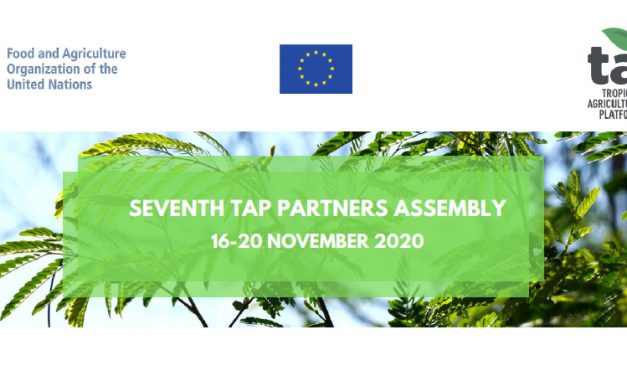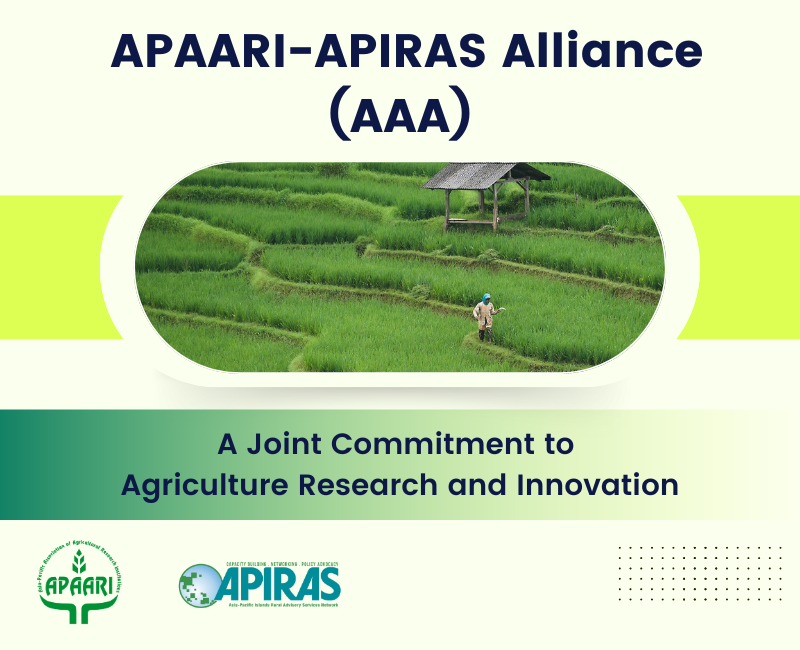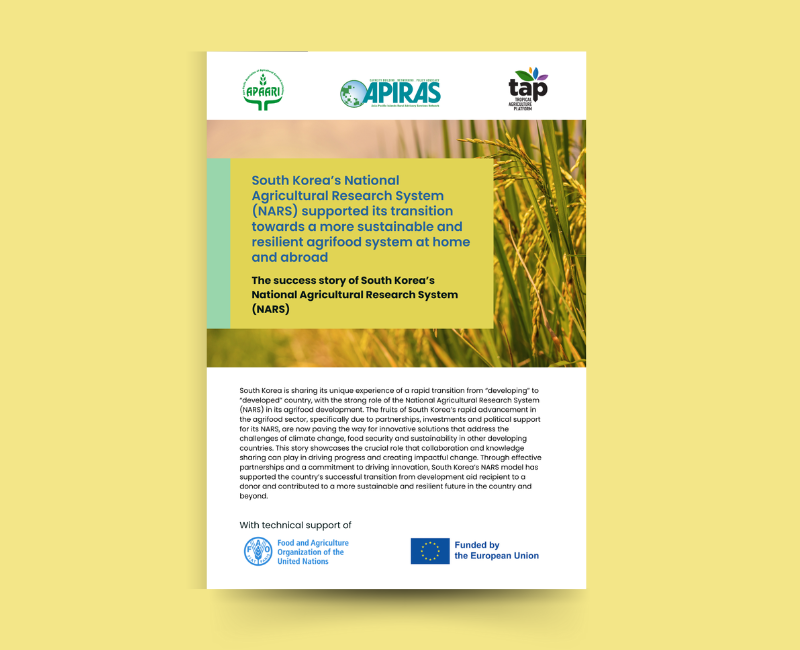APAARI was privileged to chair the seventh Partners’ Assembly of the Tropical Agriculture Platform (TAP) hosted by the Food and Agriculture Organization of the United Nations (UNFAO) under the chairmanship of Dr. Ravi Khetarpal, Executive Secretary, APAARI. The event was virtually held from 16 to 20 of November 2020 and discussed the TAP Action Plan, future work plan, and improved collaboration among the partners. Specifically, the meeting endorsed the TAP governance and related matters arising from the TAP Steering Committee and revisited the TAP Charter for possible amendments. Participants also discussed the status of implementation of the TAP Action Plan (2018-2021), and identified priority areas of the new TAP Action Plan 2022-2025. Furthermore, the partners received an update on the revision of the Common Framework by the TAP Capacity Development Expert Group. Most TAP partners were represented in the meeting.
Main event
During the main event chaired by Dr. Khetarpal, the meeting focused on (i) sharing of preliminary results of an online questionnaire; (ii) update on the TAP progress; (iii) integration of the TAP Common Framework in TAP’s partners’ programmes/projects; and (iv) experiences and lessons learned from TAP partners.
APAARI also presented its approach of integration of the TAP Common Framework and key lessons learned from the Asia Pesticide Residue Mitigation through the Promotion of Biopesticides and Enhancement of Trade Opportunities, funded by the Standards and Trade Development Facility (STDF) of the World Trade Organization (WTO). The approach focus on the blending of technical capacities related to pesticide reduction and manufacturing of biopesticides with skills, such as influencing decision-making processes in domestic pesticide issues related to biopesticide regulations, and engagement of farmers to impact pesticide use. The key lessons from this work are outlined below:
- Understanding the science behind the project in order to come up with the “blending” ideas is crucial for non-technical people, while the meaning of “functional capacities” needs to be clarified for technical people right from the beginning.
- Convincing technical people that the scientific part alone is insufficient to ensure sustainable outcomes and impact of the project requires thinking from a system perspective, which may take a lot of time and efforts.
- Mindset of the scientists tends to be on seeing the development of functional capacities as a completely separate activity; and the role of facilitation – links with KM as underestimated. These areas require dialogue and convincing.
- Creativity and innovation are stimulated through the collective learning of all project stakeholders – including the coordination team. This means that the team is considered a ‘project beneficiary’ as well.
Side events
The side events were organized on the following topics: (i) Developing Capacities for Agricultural Innovation Systems; (ii) Assessment of Agricultural Innovation Systems and Development of Country Profiles: Sharing Experiences from the Inception Phase of the TAP-AIS Project; (iii) Agricultural Science and Technology Indicators: a Critical Resources for Agricultural System Capacity Development; and (iv) Regional Dialogue on Capacity Development in Agricultural Innovation Systems in Asia, Africa, and Latin America: Lessons and Experiences from the Joint Rapid Appraisals (JRA)
APAARI was actively involved in two side events, namely Agricultural Science and Technology Indicators: A Critical Resources for Agricultural System Capacity Development and Regional Dialogue on Capacity Development in Agricultural Innovation Systems in Asia, Africa, and Latin America: Lessons and Experiences from the Joint Rapid Appraisals (JRA).
Investments in strengthening AIS
The session on JRA particularly explored the findings of the ongoing assessment that APAARI is conducting with the Asia-Pacific Islands Rural Advisory Services Network (APIRAS). The assessment teams from Asia, Africa and Latin America highlighted some key lessons from their respective regions in strengthening AIS, as well as the main gaps in approaches for strengthening the system. Furthermore, they discussed how TAP tools and approaches can be integrated or institutionalized to fill the gaps.
The Asia team also shared the highlights of various investment options for strengthening AIS in the region. The study particularly found that that in many countries, governments and donors have been investing mainly in building and strengthening agricultural R&D capacities, such as the quality of research, and focusing on support to science and technology. However, increasingly we also see a growing trend of including the development of non-technical capacities in various development programmes. While generally across the regions, countries do not tend to refer to these capacities as capacities for innovation, the study in Asia found three types of such capacity development interventions that Asian countries have been investing in to contribute towards boosting the innovative capacity of the AIS in the region. These are;
- Education and training, which includes, for example, entrepreneurship and agri-business management in the form of vocational training for farmers and agro-business professionals, university education, as well as various capacity improvements in the quality of extension and advisory services.
- Multi-stakeholder projects and platforms that focus more on rural transformation through facilitation of collaboration, partnership and engagement among different actors and institutions for catalyzing change, particularly in the areas of market system development and value chain improvement.
- Institutional development that improves capacities, such as institutional coordination, leadership, research management systems, gender-integrated planning for strategy development and collaboration between research institutions and the private sector.
While these initiatives are ongoing across Asia, we have found that more efforts need to be invested in the development of functional capacities and promoting the AIS perspective. The culture of innovation is generally lacking to build integrated and well-functioning national innovation systems, which need to be built systematically.
Since it takes long-term efforts to change the existing AIS, often due to a complex set of institutional, political, and socio-economic constraints, the study recommends that the focus of capacity development investments should be on achieving more practical results through developing capacity for collaboration and engagement between research institutions, universities, and the private sector. However, this requires innovative ways of collaboration, moving beyond the current arrangements based on linear technology transfer that is still prevailing especially in Asian public research institutions. Farmers need to be part of these innovation systems, playing an active role, not just the recipients of technologies.
Furthermore, national governments need to invest in removing the obstacles for innovation – an area where the TAP AIS model can assist countries to help identify these obstacles at different levels. Country governments need to look beyond their expenditures on R&D activities and start improving innovation enablers, which includes capacities of key innovation actors. This may be possible through different ways of working, rather than significant financial investments. Furthermore, top-down national policies are often obstacles to fostering innovation, so addressing them is part of creation of the enabling environment for innovation and bringing more coherence.
A key concluding point highlighted by APAARI was that there is no doubt that capacity development for innovation is very important. However, capacity development for innovation and development of knowledge management systems need to go hand in hand. While countries increasingly invest in capacities for R&D, many of them face problems in dissemination and demonstration of research and good practices for other countries to follow. Building KM capacities to develop outreach models that enable large-scale adoption of good practices; as well as facilitation of learning and documentation of these good practices is equally important, and is a crucial part of functional capacity development. Combined, such efforts can play a huge role in promoting a shift of mindset and attitudes for building innovation culture in the region.



